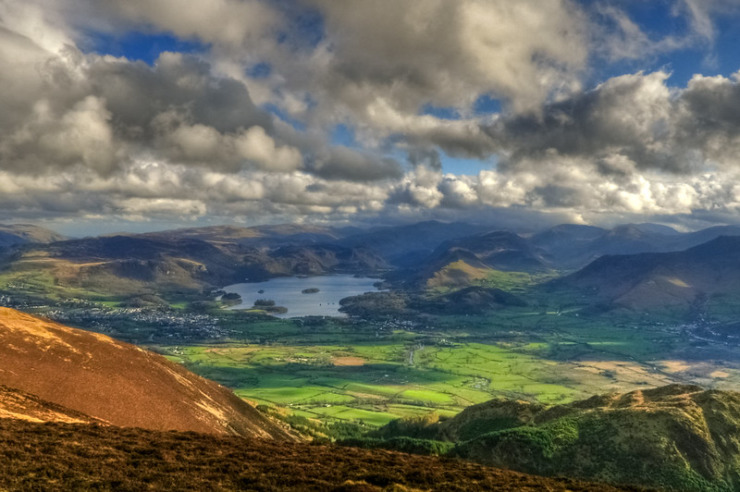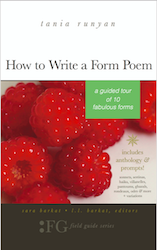Poet-a-Day: Meet Jill Baumgaertner
I’ve had the pleasure of knowing Jill Baumgaertner for over a decade. She and I share many of the same Chicago-area poetry friends, and she’s been a tireless encourager and supporter of my work. Most importantly, she and I both share an affinity for rat terriers, the best dogs in the world.
Baumgaertner’s “Cumbria Pantoum” is a beautiful addition to How to Write a Form Poem. No rat terriers appear in these lines, but cows, sheep, and birds weave in and out of the mesmerizing form. Check out the first few stanzas below …
Cumbria Pantoum (excerpt)
The blue soughs into grey.
In and out of fog the cow
Stands in the flecked greenness of the hill,
Her head shaking the mist away.
In and out of fog the cow
Forces the clouds lower than they were. She stands,
Her head shaking the mist away
In this place I have visited before.
Forcing the clouds lower than they were she stands
Closer than you are to me now
In this place I have visited in dreams,
Waking into a path balanced with stones …
—Jill Baumgaertner
Here’s what the poet has to say about “Cumbria Pantoum.”
Tania Runyan (TR): Tell me a little about the origin story of this poem.
Jill Baumgaertner (JB): “Cumbria Pantoum” happened one summer when I took a group of students to England and Ireland for seven weeks of literature in the lands that inspired it. In both the rainy Lake District (Cumbria) in England where we studied Wordsworth and Coleridge, and the west of Ireland where we studied Yeats and toured the Ring of Kerry in the fog, we experienced soggy, relentless weather that actually added a dimension to the landscapes we observed, often from our bus’s windows. It was like living inside a dream of images that would appear and fade and be replaced by other images—like something both frightening and enticing, the landscapes saturated with mystery and beauty.
TR:Why did you decide to write the poem as a pantoum? Or did the form “cause” the poem to happen?
JB: The pantoum seemed perfectly fitted to the experience since the rural landscapes provided much the same set of images over and over—sheep, the occasional cow, the stone fences, the dream. The repetition in the poem was like a repeated dream of a place I had never been—and yet I knew it well. The repetition was also somewhat incantatory and comforting.
TR: What do you hope poets can learn from a book like How to Write a Form Poem?
JB: Writing in form teaches us to find new and surprising opportunities in limitation, in boundaries which at first can seem confining but in reality force us out of the expected and ordinary into new ways of thinking. Learning to write in form helps us to upset the usual. A manual with examples and how-to instructions would have been such a help to me as I tried on the forms and as I taught them in creative writing classes.
About Jill Baumgaertner
Jill Peláez Baumgaertner is Professor of English Emerita and former Dean of Humanities and Theological Studies at Wheaton College, where she also served as Acting Provost in 2018. She received the PhD from Emory University and taught at Valparaiso University. The author of six collections of poetry, including What Cannot Be Fixed (Cascade) and the forthcoming From Shade to Shine (Paraclete); a textbook on poetry (Harcourt Brace Jovanovich); a book on Flannery O’Connor (Harold Shaw, Cornerstone, Cascade); and the poetry anthology Imago Dei (Abilene Christian), she has also written lyrics for compositions by Richard Hillert, Carl Schalk, Michael Costello, and Daniel Kellogg. Her most recent libretto is for a cantata composed by Michael Gandolfi and to be performed by the Boston Symphony Chamber Musicians. She received a Fulbright to Spain and has won many awards for her poetry. She serves as poetry editor of The Christian Century.
Hear Jill Read “Where Are All My Lost Addresses”
go to 20:30 to hear Jill read
Photo by sagesolar, Creative Commons, via Flickr. Post by Tania Runyan.
Browse more Poet-a-Day
Browse 50 States of Generosity
Check out The Yellow Wall-paper Graphic Novel
BUY ‘HOW TO WRITE A FORM POEM’ NOW!
- Flowers of California: California Poppy - December 8, 2022
- Flowers of California: Lily of the Nile - October 13, 2022
- Flowers of California: Crape Myrtle - October 5, 2022



Leave a Reply